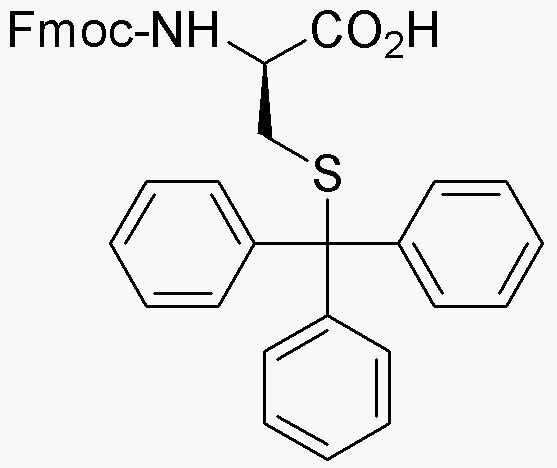Fmoc-S-trityl-D-cysteine is widely utilized in research focused on:
- Peptide Synthesis: This compound serves as a protecting group for cysteine residues during peptide synthesis, allowing for the selective modification of other amino acids without interfering with the thiol group.
- Drug Development: Its role in the synthesis of peptide-based drugs is crucial, particularly in creating compounds that target specific biological pathways, enhancing therapeutic efficacy.
- Bioconjugation: The chemical is used in bioconjugation techniques, facilitating the attachment of drugs or imaging agents to proteins, which is vital in developing targeted therapies and diagnostic tools.
- Research in Biochemistry: It aids in studying protein folding and interactions, providing insights into cellular processes and disease mechanisms, which is essential for developing new treatments.
- Material Science: The compound is explored for its potential in creating novel materials, such as hydrogels or nanomaterials, which can be used in drug delivery systems or biosensors.
General Information
Properties
Safety and Regulations
Applications
Fmoc-S-trityl-D-cysteine is widely utilized in research focused on:
- Peptide Synthesis: This compound serves as a protecting group for cysteine residues during peptide synthesis, allowing for the selective modification of other amino acids without interfering with the thiol group.
- Drug Development: Its role in the synthesis of peptide-based drugs is crucial, particularly in creating compounds that target specific biological pathways, enhancing therapeutic efficacy.
- Bioconjugation: The chemical is used in bioconjugation techniques, facilitating the attachment of drugs or imaging agents to proteins, which is vital in developing targeted therapies and diagnostic tools.
- Research in Biochemistry: It aids in studying protein folding and interactions, providing insights into cellular processes and disease mechanisms, which is essential for developing new treatments.
- Material Science: The compound is explored for its potential in creating novel materials, such as hydrogels or nanomaterials, which can be used in drug delivery systems or biosensors.
Documents
Safety Data Sheets (SDS)
The SDS provides comprehensive safety information on handling, storage, and disposal of the product.
Product Specification (PS)
The PS provides a comprehensive breakdown of the product’s properties, including chemical composition, physical state, purity, and storage requirements. It also details acceptable quality ranges and the product's intended applications.
Certificates of Analysis (COA)
Search for Certificates of Analysis (COA) by entering the products Lot Number. Lot and Batch Numbers can be found on a product’s label following the words ‘Lot’ or ‘Batch’.
Numéro de catalogue
Numéro de lot/série
Certificates Of Origin (COO)
This COO confirms the country where the product was manufactured, and also details the materials and components used in it and whether it is derived from natural, synthetic, or other specific sources. This certificate may be required for customs, trade, and regulatory compliance.
Numéro de catalogue
Numéro de lot/série
Safety Data Sheets (SDS)
The SDS provides comprehensive safety information on handling, storage, and disposal of the product.
DownloadProduct Specification (PS)
The PS provides a comprehensive breakdown of the product’s properties, including chemical composition, physical state, purity, and storage requirements. It also details acceptable quality ranges and the product's intended applications.
DownloadCertificates of Analysis (COA)
Search for Certificates of Analysis (COA) by entering the products Lot Number. Lot and Batch Numbers can be found on a product’s label following the words ‘Lot’ or ‘Batch’.
Numéro de catalogue
Numéro de lot/série
Certificates Of Origin (COO)
This COO confirms the country where the product was manufactured, and also details the materials and components used in it and whether it is derived from natural, synthetic, or other specific sources. This certificate may be required for customs, trade, and regulatory compliance.


